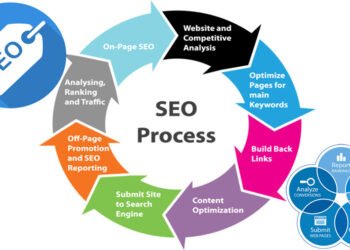In the fast-paced world of digital marketing, mastering SEO is a necessity. It’s the key to driving organic traffic and improving a website’s visibility. But with search engines constantly updating their algorithms, keeping up with the latest SEO best practices can be a daunting task.
Yet, it’s not an insurmountable challenge. By understanding the core principles and implementing strategic techniques, one can significantly enhance their website’s SEO performance. This article aims to shed light on these best practices, providing valuable insights for both beginners and seasoned professionals.
Whether you’re a small business owner trying to make your mark or a seasoned marketer staying ahead of the game, these SEO best practices will serve as your guide. Let’s dive into the world of SEO and discover the strategies that will propel your website to the top of search engine results.
Understanding SEO
In the vast landscape of digital marketing, SEO, or Search Engine Optimization, plays a pivotal role. It’s the lever that controls the quality and quantity of website traffic that comes organically from search engines, acting as a bridge that connects potential clients with the services or products they’re seeking.
SEO is not merely a bundle of keywords stuffed into a webpage. It encompasses several elements. Some of the significant ones include:
- Quality content
- Relevancy of the content
- Backlinks
- Mobile optimization
- User experience
- Social signals
One could compare it to a sophisticated game of chess, where each element carries its importance, but it’s their strategic interplay that secures the win. Unlike paid traffic, which lasts only as long as the budget allows, the outcomes of SEO are long-term. At its heart, SEO is about understanding what people are looking for online and ensuring that one’s website can meet those needs.
However, it’s also a discipline that’s always evolving. Search engine algorithms change continually, and marketers have to keep pace. It can be a daunting task, especially when your passion lies in running your business, not chasing after elusive algorithms.
Yet, the importance of mastering SEO remains undeniable. In an era where virtually every business has an online presence, SEO is not simply optional anymore. It’s a necessity for anyone willing to compete in the digital age. This understanding of SEO gives you the tools to embark on a journey towards improved website visibility and organic traffic.
As the passage unfolds, you’ll find valuable insights and best practices that can help you navigate the complexities of SEO. Whether you’re a seasoned professional or just starting your digital marketing journey, this guide will serve as a resource to propel your website to the top of search engine results.
One cannot overstate the importance of keeping abreast with the latest SEO tactics and trends. Though SEO is an ongoing process, the efforts one puts into it are, more often than not, rewarded with higher visibility and increased organic traffic. This suggests that SEO is an investment in your website’s future, helping you stay ahead of the game in the competitive arena of digital marketing.
Importance of SEO Best Practices
In the current digital landscape, the significance of SEO can’t be overstated. SEO best practices act as a roadmap to guide businesses in optimizing their online presence and help them achieve higher visibility on search engines. They steer the strategies for driving consistent, high-quality traffic to websites.
SEO best practices don’t just preach stuffing keywords into content. It’s a holistic process that combines several components. Quality content, relevancy of information, building trustworthy backlinks, mobile-friendly websites, an impressive user experience, and leveraging social signals all form part of this mechanism. Each of these elements plays a crucial role in boosting a website’s search engine rankings and broadening its virtual visibility.
SEO is not a quick fix; it is a long-term strategy. To reap its benefits, one has to be patient and persistent. It’s similar to planting a seed and nurturing it to grow into a healthy tree. Initial efforts may not yield immediate results, but the long-term gains make it worth the wait.
Here’s a brief look at the long-term benefits of SEO:
| Benefits | Details |
| Visibility | Increased visibility on search engines leads to more organic traffic. |
| Credibility | Good SEO practices convey the message that your website is trustworthy and relevant. |
| User Experience | An SEO optimized website offers superior user experience leading to higher engagement rates. |
| ROI | SEO delivers a higher return on investment compared to paid advertising methods. |
Another key aspect to keep in mind is that search engine algorithms keep evolving. Given this, it becomes instrumental for anyone managing a website to stay updated with the latest SEO trends and techniques. This continual learning and adaptation will serve as an investment in a website’s future success and longevity.
Mastering SEO not only enhances a website’s performance but also provides the traction needed to stay ahead of competitors. It’s critical to remember that competition isn’t just about who’s been around longer but who’s willing to adapt faster to the ever-changing virtual marketplace.
Core Principles of SEO
Understanding the Core Principles of SEO is instrumental in carrying out SEO best practices. They serve as the backbone for any successful SEO strategy. Knowing these principles helps businesses tailor their web presence, influence their visibility on search engine result pages (SERPs), and fortify their online reputation.
The first core principle of SEO is relevancy. Search engines strive to provide the most relevant results for a user’s query. It’s imperative that the content on your website is relevant to the keywords you want to rank for. This relevancy isn’t just about keywords; it includes making sure the content provided truly answers the searcher’s query.
Next, quality content is integral to SEO success. Producing original and valuable content not only entices users to stay on your website longer, but it also signals search engines that your site provides valuable information, aiding in higher ranking on SERPs.
Backlinks take the third place, these are essentially votes of confidence from other websites. Search engines view backlinks as an endorsement of your content’s quality and relevance. A strong backlink profile reflects favorably on your website’s ranking.
The importance of mobile optimization can’t be overstated in today’s mobile-first world. With more users accessing the internet via smartphones than desktop computers, ensuring your website is mobile-friendly is no longer optional. It’s a must.
Understanding and improving user experience (UX) contributes to your SEO success as it influences how users interact with your site. A positive user experience can lead to longer visits, more clicks, and more conversions, which search engines will see as a sign of your site’s quality.
Finally, social signals, such as shares, likes, and comments on social platforms, play a role too. Engaging with your audience on social media can help improve your website’s credibility and visibility.
The core principles of SEO are interconnected. By consistently adhering to these principles, you’re far more likely to witness an improvement in your website’s rankings over time. It’s important to remain informed about the latest trends in SEO as they are an investment for your website’s future success in the ever-evolving virtual marketplace.
Keyword Research and Optimization
Keyword research is the backbone of the SEO process. It’s all about understanding the language your prospects use when searching for the products, services, or information you provide. Without relevant keywords, your content may not reach the audience you desire.
There are several tools, such as Google’s Keyword Planner, that can help identify relevant keywords. These tools reveal the search volume, competitiveness, and even provide suggestions for related keywords. You need to assess the balance between the search volume (how many people are actually looking for that term) and competitiveness (how difficult it will be to rank highly for the keyword due to competition from other websites).
Once you’ve identified the appropriate keywords, their placement in content becomes crucial. Keywords aren’t meant to be stuffed randomly in your content; this is considered a bad practice by search engines. They should be placed tactically in title tags, meta descriptions, introductory sentences, heading tags, and throughout the body where relevant and natural.
Long tail keywords, which are strings of words that make a phrase, have a lower search volume but often convert better because they’re more specific. This type of keywords can significantly increase your site’s visibility to highly targeted searchers. The conversion rates for these can be as high as 36%, a significant improvement over more general keywords
Here’s a quick breakdown of the numbers:
| Keyword Type | Average Search Volume | Conversion Rate |
| General Keyword | High | 2% |
| Long Tail Keywords | Low | 36% |
SEO isn’t just about pleasing search engines; it’s more about delivering a positive user experience and generating relevant traffic. When used correctly, keywords guide your visitors through your site, letting them know what to expect at every turn, forcing your site to answer crucial questions and thus providing value to the visitors. By maintaining relevance between your keywords, content, and users’ search queries, you’ll be effectively leveraging your website’s potential and climbing the ladder of success.
Technical SEO
Posting high-quality content isn’t enough to ensure a high-ranking presence on search engines. A crucial but often overlooked aspect of SEO is the technical foundation of a website. Technical SEO refers to the backend structuring and optimization of a website that aids search engines in crawling and indexing it effectively. It’s the unseen hero that impacts a site’s visibility as much as keyword optimization or high-quality content.
Website speed plays an indispensable role in technical SEO. Faster loading websites deliver a superior user experience and are favored by search engines. Google’s PageSpeed Insights tool provides a comprehensive analysis of a site’s performance and offers suggestions for improvement.
Similarly, a website’s structure is another pivotal point in technical SEO. A logically organized, easily navigable site structure helps search engines understand and index your website more efficiently. It’s also instrumental in improving user experience which indirectly affects ranking.
Creating and regularly updating a site’s XML sitemap ensures search engines are informed about all the pages on a website including how they relate to one another. This greatly assists in the indexing process.
Moreover, it’s critical to ensure a website is mobile-friendly. With the rise of mobile users, search engines like Google have switched to mobile-first indexing. That means the mobile version of a website is the primary one for ranking.
Finally, security cannot be overlooked. Websites that use HTTPS protocol tend to rank higher since users trust and are likely to revisit secure websites. Google also explicitly marks sites without HTTPS as not secure which can deter potential visitors.
So while Technical SEO may not be the most glamorous part of the SEO process, it sets the stage for all other strategies. It ensures a website is secure, speedy, easy to navigate, mobile-optimized, and easily discovered by search engines.
Next up, we delve into the equally important but often perplexing realm of SEO analytics and metrics, to further refine and measure the efficacy of an SEO strategy.
On-Page SEO
Following the core principles of SEO and understanding the importance of technical SEO, let’s dive into another significant aspect known as On-Page SEO. This strategy primarily focuses on optimizing individual web pages for search engines and users alike. It includes keyword placement, content quality, and other vital components of a webpage.
At its core, the main objective of on-page SEO is to help search engines understand the content and context of a webpage. This understanding allows search engines to correctly index web pages and help users find relevant information. It’s also crucial for enhancing the user experience, which can indirectly improve search engine rankings.
One key aspect of on-page SEO is the strategic placement of keywords. As previously mentioned, keyword research assists in finding the right terms and phrases that potential customers are using. But it’s equally important to use these keywords appropriately throughout the content. Including keywords in the title, subheadings, and meta descriptions can drastically improve the page’s visibility.
Following keyword placement, it’s necessary to pay attention to content quality. It’s no longer enough to simply sprinkle keywords throughout a webpage’s content. The content must be well-written and provide valuable information to the reader. Google’s algorithm prioritizes pages that provide value to users, rewarding them with higher search rankings.
Additionally, HTML tags, URL structures, and image optimization also play vital roles in on-page SEO. HTML tags, such as header tags and alt tags for images, help search engines understand the content on a page. Clean URL structures aid both the users and search engines in navigating the website. Meanwhile, optimizing images for web ensures faster loading times, contributing to a better user experience.
In moving forward, we’ll discuss how off-page SEO complements on-page SEO. Don’t forget, the goal is to provide the best user experience possible and maintain a robust online presence. Keep an eye out for the latest SEO trends and continue optimizing your strategies. Remember, SEO is an ongoing process that requires time and patience to yield the desired results.
Off-Page SEO
After exploring the cogs and gears of on-page SEO, it’s crucial to venture out and understand the sphere of Off-Page SEO. It’s another critical component of a comprehensive and effective SEO strategy.
Off-page SEO relates to all actions that one can take outside their website to improve its ranking on search engines. The primary goal, although it might seem indirect, is to increase your website’s prominence and authority, leading to higher website traffic.
How does one improve their website’s authority? The answer to this lies in backlinks. They are external links to a website from other related, relevant sites. A high number of quality backlinks can indicate to search engines that a website is a credible source of information.
However, it’s key to remember that not all backlinks are created equal. Prioritizing quality over quantity is crucial. A few high-quality backlinks from authoritative sites can outshine hundreds of low-quality links from sites with less credibility.
Aside from backlinks, off-page SEO also includes social media marketing and brand mentions. Both play significant roles in enhancing the reputation of a website. Social media platforms could serve as a launchpad for content, thereby potentially increasing the likelihood for natural backlinks. Brand mentions, either linked or unlinked, may assist search engines in discerning the popularity or renown of a brand online.
Further examples of off-page SEO strategies could include:
- Guest blogging
- Influencer outreach
- Podcast interviews
By understanding and implementing off-page SEO tactics, one can help influence search engines’ perception regarding a website’s relevance, authority, and trustworthiness. At the same time, they are creating a network outside their direct control yet complementary to on-page SEO efforts.
Mobile Optimization
Moving along the line of SEO best practices, we venture into Mobile Optimization, another critical aspect of the strategy. It’s a facet that can’t be overlooked in an era where most internet users are glued to their mobile devices.
Mobile optimization refers to the process of adjusting your website content to ensure that visitors who access the site from mobile devices have an experience optimized for their device. The goal is straightforward: format the website so it’s easy—and appealing—to interact with (no excess scrolling or zooming required).
What’s the reason behind the hype about mobile optimization? Simply, the prevalence of mobile usage in today’s digital space. A report by Statista showcased that in the first quarter of 2021, mobile devices (not including tablets) generated 54.8 percent of global website traffic. This data indicates the critical role mobile optimization plays in a comprehensive SEO strategy.
Google also recognizes the importance of mobile-friendly web design—so much so that it has implemented mobile-first indexing. This means Google predominantly uses the mobile version of the content for indexing and ranking. If a website doesn’t meet Google’s standards for mobile optimization, it could likely negatively impact the site’s SEO performance.
Here’s an overview of how mobile traffic has been increasing over the years:
| Year | Percentage of Global Website Traffic from Mobile Devices |
| 2017 | 50.3% |
| 2018 | 52.2% |
| 2019 | 53.3% |
| 2020 | 54.1% |
| 2021 Q1 | 54.8% |
To ensure mobile optimization, consider employing techniques like:
- Responsive web design
- Prioritizing website speed
- Designing for the fingertip (easy navigation)
- Avoiding pop-ups that might hamper the user experience
By focusing on these elements, one can build a mobile-friendly website that not only delights visitors but also pleases the search engines. Because, for SEO to truly succeed, it cannot ignore the burgeoning force of mobile users.
User Experience and SEO
Moving further with SEO best practices, another concept gaining significant importance is the user experience (UX). It’s integral to a successful SEO strategy and its significance can’t be overstated. User experience focuses on making a website’s interaction as simple and efficient as possible for the users.
Google’s algorithms now consider UX as an essential metric evaluating the website’s ranking on the SERP (Search Engine Results Page). Sites providing enhanced user experience often have lower bounce rates, increased engagement and high user retention. This implies that user-friendly websites have a higher likelihood to rank better in the search results.
One key aspect of user experience is the site’s load time. Users are likely to exit a webpage if it takes more than three seconds to load. In fact, a delay of just a second in load times can lead to a 7% decline in conversions.
UX also involves ensuring the website’s design is visually pleasing and that the content is easy to read. A crucial element in enhancing readability is the effective application of whitespace – the empty spaces surrounding texts and graphics. Whitespace improves readability and content comprehension, making the site more user-friendly.
Ensuring a seamless navigational experience for users is another critical aspect of UX. An intuitive navigation is one that is self-explanatory and simple to use. It’s recommended to have a consistent and methodological navigational structure that guides the user from one page to another without any confusion. This includes having a breadcrumb trail to enable the user to track their journey on the website.
Lastly, employing a mobile-first design approach is also an important aspect of UX. Earlier in the article, we called attention to the importance of mobile optimization: this is a key example of why it’s so significant. When we talk about user experience, we’re talking about all users – desktop and mobile alike.
Focusing on enhancing UX could yield significant improvements in your SEO strategy.
Measurement and Analysis
Having explored the critical elements of SEO such as on-page, off-page, mobile optimization, and the impact of user experience, there’s another crucial aspect to discuss – measurement and analysis. Implementing SEO strategies isn’t enough. One must continually monitor, measure, and analyze the performance of implemented strategies to ensure they’re delivering the desired results.
One of the key tools in the measurement and analysis arsenal is Google Analytics. It provides an in-depth analysis of web traffic, user behavior, and conversion data. It answers questions like where the traffic is coming from, what content resonates most with the users, and what paths users typically take to make conversions.
Keyword ranking is another metric to closely watch. Keyword ranking impacts how visible a website is in the SERPs. This is why it’s critical to track the performance of the selected keywords and make adjustments as necessary. Tools such as Moz and SEMRush allow for tracking and optimization of your keyword strategies.
Additionally, examining backlinks proves beneficial. Backlinks represent the quality and quantity of sites linking back to a website. They’re a vital part of SEO and are generally viewed positively by search engines. Tools like Ahrefs and Majestic SEO allow for analysing and optimizing backlinks, ensuring they’re high quality and relevant.
Lastly, dive into user engagement metrics, such as bounce rate, average session times, and page views per session. These metrics help paint a clearer picture of how users are interacting with the website, providing insights into what’s working and what needs revision.
The value in measurement and analysis lies in its potential to provide direction, insight, and the necessary data needed to refine and optimize SEO strategies as needed. By using the right tools and monitoring the right metrics, it becomes easier to ensure the continual effectiveness of SEO efforts.
Remember, SEO is not a one-off task, it’s an ongoing process. Keep refining and keep measuring. That’s the key to lasting success. Note though, there’s no need to close here – there’s still much to learn.
SEO isn’t a one-time effort but a continuous process that demands constant refinement and measurement. With a focus on enhancing user experience, from mobile optimization to intuitive navigation, one can significantly boost their website’s ranking on SERPs. It’s also essential to measure and analyze the performance of SEO strategies to ensure their effectiveness. Tools such as Google Analytics, Moz, SEMRush, Ahrefs, and Majestic SEO can aid in tracking and optimizing various metrics. Remember, the key to SEO success is an ongoing commitment to learning, adapting, and refining strategies based on data-driven insights. Keep up with the ever-evolving SEO best practices and you’ll see lasting success in your digital presence.












